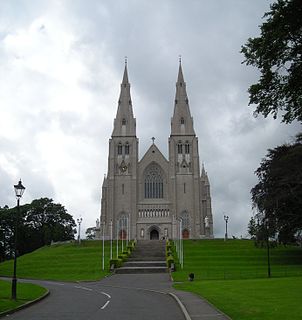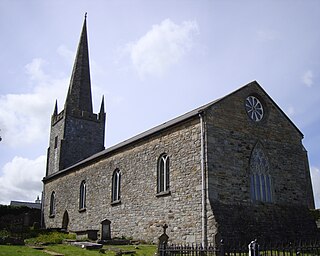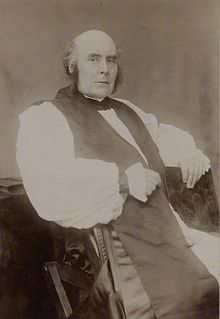Related Research Articles

The Church of Ireland is a Christian church in Ireland and an autonomous province of the Anglican Communion. It is organised on an all-Ireland basis and is the second largest Christian church on the island after the Roman Catholic Church. Like other Anglican churches, it has retained elements of pre-Reformation practice, notably its episcopal polity, while rejecting the primacy of the Pope.
The Primacy of Ireland was historically disputed between the Archbishop of Armagh and the Archbishop of Dublin until finally settled by Pope Innocent VI. Primate is a title of honour denoting ceremonial precedence in the Church, and in the Middle Ages there was an intense rivalry between the two archbishoprics as to seniority. Since 1353 the Archbishop of Armagh has been titled Primate of All Ireland and the Archbishop of Dublin Primate of Ireland, signifying that they are the senior churchmen in the island of Ireland, the Primate of All Ireland being the more senior. The titles are used by both the Catholic and Church of Ireland bishops. The distinction mirrors that in the Church of England between the Primate of All England, the Archbishop of Canterbury, and the Primate of England, the Archbishop of York.

The Irish Church Act 1869 was an Act of the Parliament of the United Kingdom which separated the Church of Ireland from the Church of England and disestablished the former, a body that commanded the adherence of a small minority of the population of Ireland. The Act was passed during the first ministry of William Ewart Gladstone and came into force on 1 January 1871. It was strongly opposed by Conservatives in both houses of Parliament.
The Archbishop of Cashel was an archiepiscopal title which took its name after the town of Cashel, County Tipperary in Ireland. Following the Reformation, there had been parallel apostolic successions to the title: one in the Church of Ireland and the other in the Roman Catholic Church. The archbishop of each denomination also held the title of Bishop of Emly. The Church of Ireland title was downgraded to a bishopric in 1838, and in the Roman Catholic Church it was superseded by the role of Archbishop of Cashel and Emly when the two dioceses were united in 2015.
The Anglican Archbishop of Armagh is the ecclesiastical head of the Church of Ireland, bearing the title Primate of All Ireland, the metropolitan of the Province of Armagh and the diocesan bishop of the Diocese of Armagh.

The Archdiocese of Armagh is an ecclesiastical territory or archdiocese of the Catholic Church located in the northern part of Ireland. The ordinary is the Roman Catholic Archbishop of Armagh who is also the Metropolitan of the Ecclesiastical province of Armagh and the Primate of All Ireland. The mother church is St Patrick's Cathedral. The claim of the archdiocese to pre-eminence in Ireland as the primatial see rests upon its traditional establishment by Saint Patrick circa 445. It was recognised as a metropolitan province in 1152 by the Synod of Kells.

The United Provinces of Dublin and Cashel, commonly called the Province of Dublin, and also known as the Southern Province, is one of the two ecclesiastical provinces that together form the Church of Ireland; the other is the Province of Armagh. The province has existed since 1833 when the ancient Province of Dublin was merged with the Province of Cashel. Its metropolitan bishop is the Archbishop of Dublin.

The Bishop of Killala is an episcopal title which takes its name after the village of Killala in County Mayo, Ireland. In the Roman Catholic Church it remains a separate title, but in the Church of Ireland it has been united with other bishoprics.
The Archbishopric of Tuam existed from the mid twelfth century until 1839, with its seat at Tuam.
William Moreton was an English prelate in the Church of Ireland who served as the Bishop of Meath from 1705-1716.
The Bishop of Killala and Achonry was the Ordinary of the Church of Ireland diocese of Killala and Achonry in the Ecclesiastical Province of Tuam. The diocese comprised part of Counties Mayo and Sligo in Ireland.

The Archbishop of Armagh is an archiepiscopal title which takes its name from the city of Armagh in Northern Ireland. Since the Reformation, there have been parallel apostolic successions to the title: one in the Roman Catholic Church and the other in the Church of Ireland. The archbishop of each denomination also holds the title of Primate of All Ireland.
William Reeves was an Irish antiquarian and the Church of Ireland Bishop of Down, Connor and Dromore from 1886 until his death. He was the last private keeper of the Book of Armagh and at the time of his death was President of the Royal Irish Academy.

Marcus Gervais Beresford was the Church of Ireland Bishop of Kilmore, Elphin and Ardagh from 1854 to 1862 and Archbishop of Armagh and Primate of All Ireland from 1862 until his death.

The Archbishop of Dublin is an archiepiscopal title which takes its name after Dublin, Ireland. Since the Reformation, there have been parallel apostolic successions to the title: one in the Catholic Church and the other in the Church of Ireland. The archbishop of each denomination also holds the title of Primate of Ireland.

Christopher Hampton (1552–1625) was an Englishman who was the Church of Ireland Archbishop of Armagh from 1613 to 1625.
The Board of First Fruits was an institution of the Church of Ireland that was established in 1711 by Anne, Queen of Great Britain to build and improve churches and glebe houses in Ireland. This was funded from taxes collected on clerical incomes which were in turn funded by tithes. The board was replaced in 1833 by the Board of Ecclesiastical Commissioners.
Joseph Welland was born in Middleton, County Cork and became an Irish Architect for the Board of First Fruits and later the Ecclesiastical Commissioners. He was as a student to John Bowden and became his assistant and is noted to have designed many churches and schools around Ireland.
William Farrell, RIAI, was a prominent Dublin-based Irish architect active throughout early to mid-nineteenth century Ireland, during the Georgian and early Victorian period, known particularly for his church and institutional designs.

Robert Samuel Gregg was a 19th-century Anglican bishop.
References
- ↑ Brooks, Chris & Saint, Andrew (1995). "The Victorian church: architecture and society", Manchester University Press, p133-134
- ↑ McDowell, R. B. (1989). "Administration and the public services, 1800–70". Ireland Under the Union 1801–70. A New History of Ireland. Vol. V. Oxford: Oxford University Press. p. 558. ISBN 978-0-19-957867-2.
- ↑ MacCarthy, R. B. (1995). A short history of the Church of Ireland: Ancient & Modern. Dublin: Four Courts Press. p. 50. ISBN 1-85182-205-4.
- 1 2 McDowell, R. B. (1989). "Administration and the public services, 1870–1921". Ireland Under the Union 1870–1921. A New History of Ireland. Vol. VI. Oxford: Oxford University Press. p. 574. ISBN 978-0-19-958374-4.
- ↑ "Topics: The Office of Public Works". pp. 4.2 National Monuments. Retrieved 2 December 2014.
- ↑ "Irish Church Act Amendment Act, 1881". Irish Statute Book . Retrieved 2 December 2014.
- ↑ Curry, William (1835). "Board of Ecclesiastical Commissioners". The picture of Dublin: or, Stranger's guide to the Irish metropolis (new ed.). Dublin: William Curry Jun. and Co. pp. 214–217. Retrieved 4 December 2014.
- ↑ "Ecclesiastical Commissioners". Dictionary of Irish Architects. Irish Architectural Archive. Retrieved 4 December 2014.